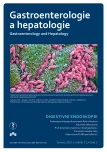Colonic decompression in daily practice
Authors:
I. Mikoviny Kajzrlíková 1; P. Vítek 1,2; J. Chalupa 1; J. Kuchař 1; J. Platoš 1; P. Řeha 1; M. Chrostek 3
Authors place of work:
Beskydské Gastrocentrum, Interní oddělení, Nemocnice ve Frýdku-Místku, p. o.
1; Lékařská fakulta OU, Ostrava
2; Beskydské Gastrocentrum, Chirurgické oddělení, Nemocnice ve Frýdku-Místku, p. o.
3
Published in the journal:
Gastroent Hepatol 2017; 71(3): 215-219
Category:
Digestivní endoskopie: původní práce
doi:
https://doi.org/10.14735/amgh2017215
Summary
Introduction:
Endoscopic management of some types of intestinal obstruction or pseudo-obstruction is an unusual indication for acute colonoscopy. The aim of this study was to assess the frequency of, indications for, and results of colonic decompression.
Methods:
All colonoscopies for intestinal obstruction or pseudo-obstruction with insertion of a decompression tube and endoscopic reduction of the sigmoid volvulus carried out from August, 2011, to December, 2016 at our institution, were retrospectively assessed. For each patient, age, sex, comorbidities, etiology of ileus and indication for decompression, part of the colon reached during acute colonoscopy, effect of decompression, and follow-up were recorded.
Results:
During the study period, 23 colonic decompressions were performed in 21 patients (11 men and 10 women) with an average age of 68 years (median, 73 years). The indication for decompression was Ogilvie’s syndrome in 14 patients, sigmoid volvulus in two patients, pseudomembranous colitis with toxic megacolon in one patient, paralytic ileus caused by ischemic colitis in one patient with multiple organ dysfunction syndrome, ileus due to benign anastomotic stricture in the rectum in one patient, and mechanical ileus that was initially considered to be Ogilvie’s syndrome in two patients. Because most of the patients were elderly with comorbidities, the 30-day mortality rate was 28.6%.
Conclusions:
The most frequent indication for colonic decompression was Ogilvie’s syndrome. The 30-day mortality rate was high because most of the patients were elderly with comorbidities. Sigmoid volvulus can be successfully managed endoscopically, and decompression is more effective with the insertion of a decompression tube.
Key words:
decompression – colonoscopy – colonic pseudo-obstruction – intestinal volvulus – mortality
The authors declare they have no potential conflicts of interest concerning drugs, products, or services used in the study.
The Editorial Board declares that the manuscript met the ICMJE „uniform requirements“ for biomedical papers.
Submitted:
18. 4. 2017
Accepted:
11. 5. 2017
Zdroje
1. Ogilvie H. Large-intestine colic due to sympathetic deprivation; a new clinical syndrome. Br Med J 1948; 2 (4579): 671–673.
2. Vanek VW, Al-Salti M. Acute pseudo-obstruction of the colon (Ogilvie’s syndrome). An analysis of 400 cases. Dis Colon Rectum 1986; 29 (3): 203–210.
3. Camilleri M. Acute colonic pseudo-obstruction (Ogilvie’s syndrome). [online]. Available from: www.uptodate.com.
4. Ponec RJ, Saunders MD, Kimmey MB. Neostigmine for the treatment of acute colonic pseudo-obstruction. N Engl J Med 1999; 341 (3): 137–141.
5. Eisen GM, Baron TH, Dominitz JA et al. Acute colonic pseudo-obstruction. Gastrointest Endosc 2002; 56 (6): 789–792.
6. Kukora JS, Dent TL. Colonoscopic decompression of massive nonobstructive cecal dilation. Arch Surg 1977; 112 (4): 512–517.
7. Bode WE, Beart RW Jr, Spencer RJ et al. Colonoscopic decompression for acute pseudoobstruction of the colon (Ogilvie’s syndrome). Report of 22 cases and review of the literature. Am J Surg 1984; 147 (2): 243–245.
8. Geller A, Petersen BT, Gostout CJ. Endoscopic decompression for acute colonic pseudo-obstruction. Gastrointest Endosc 1996; 44 (2): 144–150.
9. Gan SI, Beck PL. A new look at toxic megacolon: an update and review of incidence, etiology, pathogenesis, and management. Am J Gastroenterol 2003; 98 (11): 2363–2371.
10. Falt P, Bortlik M, Kliment M. Endoskopická desuflace u toxického megakolon. In: Falt P. Koloskopie. Praha: Grada 2015.
11. Weingrow D, McCague A, Shah R et al. Delayed presentation of sigmoid volvulus in a young woman. West J Emerg Med 2012; 13 (1): 100–102. doi: 10.5811/ westjem.2011.4.6720.
12. Jones IT, Fazio VW. Colonic volvulus. Etiology and management. Dig Dis 1989; 7 (4): 203–209.
13. Catalano O. Computed tomographic appearance of sigmoid volvulus. Abdom Imaging 1996; 21 (4): 314–317.
14. Hirao K, Kikawada M, Hanyu H et al. Sigmoid volvulus showing „a whirl sign“ on CT. Intern Med 2006; 45 (5): 331–332.
15. Hodin RA. Sigmoid volvulus. [online]. Available from: www.uptodate.com.
16. Cirrocchi R, Farinella E, La Mura F et al. The sigmoid volvulus: surgical timing and mortality for different clinical types. World J Emerg Surg 2010; 5: 1. doi: 10.1186/1749-7922-5-1.
17. Roseano M, Guarino G, Cuviello A. Sigma volvulus: diagnostic and therapeutic features (considerations on 10 cases). Ann Ital Chir 2001; 72 (1): 79–84.
18. van Hooft JE, van Halsema EE, Vanbiervliet G et al. Self-expandable metal stents for obstructing colonic and extracolonic cancer: European Society of Gastrointestinal Endoscopy (ESGE) Clinical Guideline. Endoscopy 2014; 46 (11): 990–1053. doi: 10.1055/s-0034-1390700.
Štítky
Dětská gastroenterologie Gastroenterologie a hepatologie Chirurgie všeobecnáČlánek vyšel v časopise
Gastroenterologie a hepatologie

2017 Číslo 3
- Metamizol jako analgetikum první volby: kdy, pro koho, jak a proč?
- MUDr. Lenka Klimešová: Multioborová vizita může být klíčem k efektivnější perioperační léčbě chronické bolesti
- Horní limit denní dávky vitaminu D: Jaké množství je ještě bezpečné?
- Realita léčby bolesti v paliativní péči v Německu
Nejčtenější v tomto čísle
- Rifaximin
- Odporúčania Pracovnej skupiny pre IBD Slovenskej gastroenterologickej spoločnosti pre liečbu ulceróznej kolitídy
- Kolonické dekomprese v běžné praxi
- Problematická diagnostika a závažné biliárne komplikácie echinokokózy pečene
